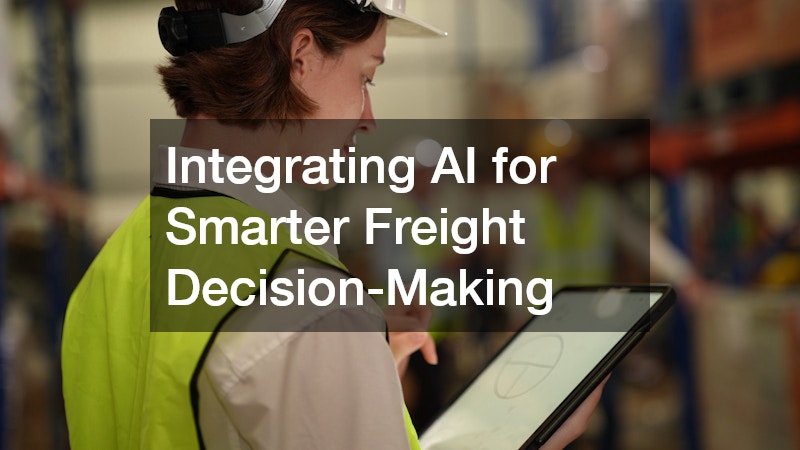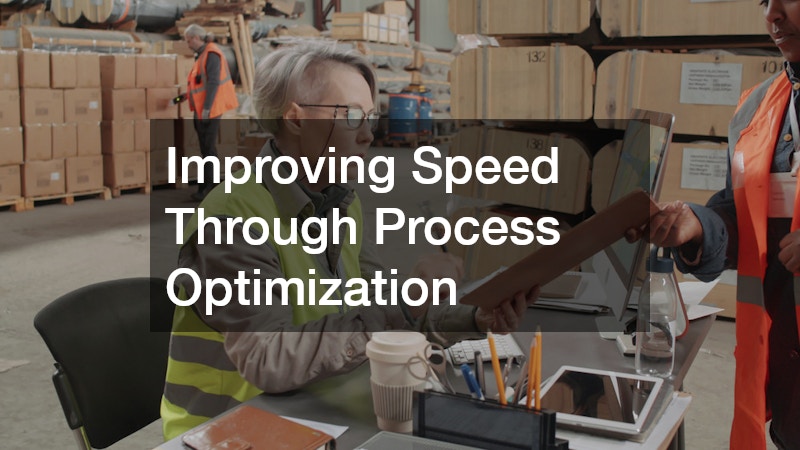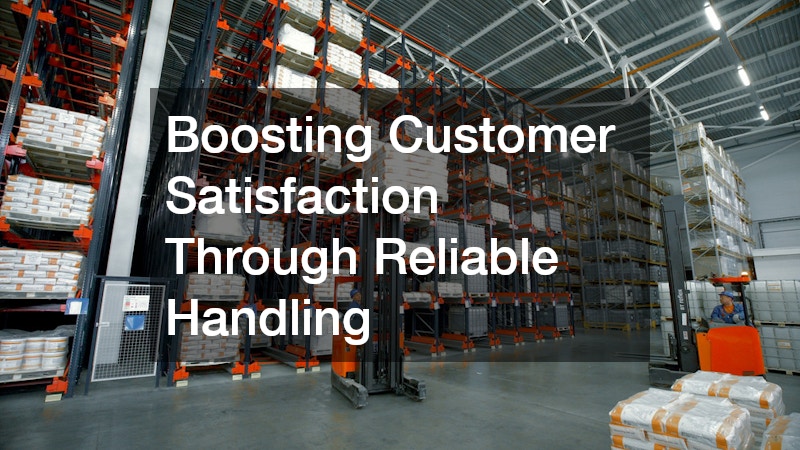In today’s fast-paced and highly competitive business environment, the pressure to scale efficiently while maintaining reliable operations is greater than ever. Companies constantly look for ways to grow without sacrificing quality, agility, or customer satisfaction. Amidst this drive for growth, one critical area often remains underappreciated: the logistics and movement of goods—specifically, the art and science of handling freight.
From automation and AI to smarter workforce strategies and green technologies, companies are now equipped with tools that didn’t exist even a decade ago. These advancements allow for greater efficiency, reduced risk, and increased adaptability—key ingredients for scaling any business. In the following sections, we’ll explore how various freight-handling innovations can serve as strategic levers for growth across a range of industries.
Leveraging Automation to Streamline Freight Handling

Automation is revolutionizing industries across the board, and logistics is no exception. In freight handling, automation refers to using technology, like conveyor belts, robotic arms, and automated storage and retrieval systems (AS/RS), to move goods more efficiently within warehouses and through distribution networks. These systems increase accuracy and reduce the labor required to perform repetitive, time-consuming tasks, freeing up human workers for higher-level problem-solving and oversight.
For companies aiming to scale, investing in automation-ready modern freight solutions can have a profound impact. These systems often include barcode scanning, AI-based load planning, and software that integrates with inventory management and delivery tracking tools. By deploying automated freight handling processes, businesses reduce operational errors and shipping delays and position themselves to handle greater volumes with the same or fewer resources. In short, automation makes scaling a matter of system expansion rather than workforce overload.
Using Data Analytics to Improve Freight Efficiency
Data analytics has become a game-changer in the world of logistics. Businesses can now collect, interpret, and act on real-time data to improve every aspect of handling freight. Whether through warehouse performance metrics, shipping time analyses, or fuel cost tracking, the insights gained from data can uncover inefficiencies and guide better decision-making.
A key area where data plays a pivotal role is in managing partnerships with freight carrier service providers. Companies can identify the most reliable carriers and negotiate better contracts by analyzing delivery times, on-time rates, and damage reports. Advanced analytics can predict demand surges, helping businesses proactively allocate resources and avoid costly delays. These insights are invaluable when scaling operations, ensuring every shipment is handled as efficiently and cost-effectively as possible.
Enhancing Safety Protocols Through Smart Technology
As businesses scale and freight volumes increase, ensuring the safety of both employees and goods becomes more critical, yet also more challenging. With higher throughput, more complex workflows, and a larger workforce, the potential for accidents, injuries, or product damage rises significantly. While important, Traditional safety training methods often fall short when managing these heightened risks in large-scale operations. As operations expand, it becomes difficult to rely solely on manual checks and generic training programs to keep up with the fast-paced demands of the logistics industry. This is where innovative technology plays a pivotal role, offering real-time monitoring and automated alerts to enhance safety protocols across the board.
Modern freight environments are now leveraging advanced technology such as sensors, geofencing, and AI-powered monitoring systems to manage safety proactively. Sensors can detect changes in temperature, movement, or vibrations, alerting managers to potential issues such as equipment malfunctions or the risk of damage to sensitive cargo. Geofencing technology can create virtual boundaries within the warehouse or along transportation routes, triggering automatic notifications if an operator or vehicle veers outside a safe zone. AI systems further enhance this capability by analyzing real-time patterns, identifying emerging risks, and suggesting corrective actions before a minor issue escalates into an accident.
One innovation enhancing safety is the implementation of tech-enhanced forklift trainings. These training programs increasingly incorporate VR simulations, real-time performance analytics, and digital certification systems to ensure that forklift operators are trained and continuously improving. These tools are particularly valuable in environments where handling freight is frequent, fast-paced, and potentially dangerous. A safer operation reduces injury-related downtime, protects assets, and builds a more resilient foundation for scaling.
Integrating AI for Smarter Freight Decision-Making

Artificial intelligence is changing how businesses approach logistics planning. From demand forecasting to dynamic pricing and load optimization, AI allows freight operations to become more adaptive and efficient. Instead of reacting to delays and disruptions, businesses can now anticipate them and respond proactively.
AI can optimize load distribution, schedule fleet maintenance, and even determine the most efficient delivery routes in real time in sectors that depend heavily on material hauling. This level of automation is invaluable when handling freight across long distances or in complex environments, such as construction sites or remote locations. By automating decision-making, businesses free up resources, reduce costs, and maintain consistency in performance, even as demand scales up.
Adopting IoT for Real-Time Freight Tracking
The need for transparency and real-time monitoring has never been higher. Clients expect to know where their goods are at any moment, and delays or damages can lead to immediate dissatisfaction. The Internet of Things (IoT) addresses these needs by allowing businesses to track freight using connected devices that report location, temperature, vibration, and other metrics in real time.
This is especially important for industries that rely on climate controlled storage, such as pharmaceuticals or food distribution. In these cases, any deviation from safe temperature ranges can result in ruined products and lost revenue. IoT technology ensures that sensitive cargo is monitored continuously while in transit and in storage. For businesses scaling into temperature-sensitive sectors, these smart systems make it possible to guarantee the quality and integrity of goods while maintaining operational control in handling freight.
Reducing Costs With Innovative Handling Equipment
Scaling a business doesn’t always require significant upfront investments in new infrastructure or long-term asset acquisition. Committing large amounts of capital to own equipment can limit a company’s financial flexibility, especially in the early stages of growth or during unpredictable market conditions. Instead, many forward-thinking organizations are adopting more cost-effective strategies, such as leasing or renting high-performance logistics equipment. This approach allows them to access the latest technology and tools needed to enhance operations, without tying up funds in assets that may not be fully utilized year-round. By avoiding the burden of ownership, businesses maintain agility while still meeting increased demand.
Modern logistics equipment offers powerful advantages in speed, precision, and labor savings, from intelligent lifting systems and autonomous pallet movers to modular conveyor belts and stackable storage units. Renting or leasing this type of equipment means businesses can scale their capabilities on demand, adapting to seasonal peaks, project-based workloads, or rapid expansion into new markets. This flexibility keeps operational costs in check, reduces maintenance concerns, and ensures access to updated technology. When chosen strategically, these temporary solutions can deliver long-term performance benefits, making them a smart part of any business’s freight-handling strategy.
That’s why many companies turn to equipment rentals. Renting allows businesses to scale up quickly during peak seasons or large projects without a long-term investment. It also allows them to test new technologies before committing to a full-scale rollout. For companies heavily handling freight, having on-demand access to reliable, up-to-date equipment ensures continuity and adaptability during critical growth phases.
Improving Speed Through Process Optimization

Efficiency in logistics goes far beyond simply increasing output; it’s about optimizing every step of the operation to achieve faster results without compromising accuracy or service quality. As businesses scale, inefficiencies that were once manageable can quickly snowball into major issues, leading to delays, errors, and customer dissatisfaction. Actual efficiency means designing systems that move products through the supply chain with minimal friction, maximizing productivity while maintaining high standards. It requires a proactive mindset focused on continuous improvement and the strategic elimination of bottlenecks that slow down the flow of goods.
To achieve this, companies must closely examine their internal processes and workflows. This includes reevaluating warehouse layouts to reduce travel time, refining staffing patterns for better labor utilization, and improving how shipments are packed and loaded to minimize handling time. Even minor adjustments—like reconfiguring shelving, investing in ergonomic tools, or updating software to reduce manual data entry—can result in significant gains over time.
When scaling up, the type and configuration of transportation equipment matter significantly. Partnering with trailer dealers who offer customized or industry-specific trailers can help speed up loading and unloading processes and reduce transportation time. Specialized trailers designed for rapid cargo access, refrigeration, or oversized loads can improve every aspect of handling freight. This operational flexibility allows businesses to consistently meet delivery windows and expand into new markets without bottlenecks.
Scaling Operations With Modular Freight Systems
One of the most significant challenges in scaling logistics operations is the risk of overcommitting resources before demand is stable. When businesses grow too quickly without flexible systems, they often invest heavily in infrastructure or hire permanent staff that may become underutilized if demand decreases or shifts unexpectedly. These fixed commitments can tie up capital, reduce operational agility, and create long-term financial strain.
To address this, many companies are turning to modular freight systems that offer flexibility and adaptability as they grow. These systems feature scalable storage units, adjustable racking, mobile equipment, and plug-and-play automation tools that can be added or removed based on volume. Additionally, adaptable workflow software allows businesses to modify their processes without a complete systems overhaul. This modular approach supports gradual growth, minimizes downtime during transitions, and helps organizations maintain consistent performance. It empowers businesses to respond quickly to market shifts while keeping operational costs in check—a critical advantage for any company looking to scale efficiently and sustainably.
Workforce scalability is essential in tandem with physical flexibility. Working with a contract staffing agency allows businesses to hire experienced workers quickly, adjusting their labor force as operations expand. Whether opening a new distribution center or managing seasonal spikes in demand, this approach supports handling freight efficiently without the cost and commitment of full-time hiring. Combining modular systems and flexible staffing creates an agile operation ready for continuous growth.
Strengthening Sustainability With Green Technologies
Sustainability is no longer just a buzzword—it’s a business imperative. Companies must make greener choices across their supply chains as environmental regulations tighten and customers become more eco-conscious. This includes upgrading fleets, reducing waste, and using energy-efficient infrastructure for handling freight.
Even traditionally fuel-dependent industries, like oil delivery companies, are adapting by investing in alternative fuels, route optimization software, and cleaner-burning engines. These changes reduce greenhouse gas emissions while lowering fuel costs—two big wins for any company looking to scale responsibly. Green logistics doesn’t just improve public image; it also builds resilience and future-proofs operations against regulatory changes and resource scarcity.
Boosting Customer Satisfaction Through Reliable Handling

Customer satisfaction is directly tied to the reliability of freight operations. No matter how great a product is, a missed delivery, damaged shipment, or communication breakdown can sour the customer experience. Maintaining a consistent and reliable freight handling process as businesses scale becomes increasingly important.
This is especially true for medical equipment suppliers, where timing and precision are not negotiable. Late or incorrect shipments can have serious consequences, making reliability in handling freight a matter of trust and responsibility. These companies rely on logistics systems that maintain visibility, temperature control, and tamper-proof tracking to ensure sensitive equipment arrives safely and on time. When customers know they can depend on a business for consistent service, it fosters loyalty, an invaluable asset during rapid growth.
As we’ve explored, innovations in freight handling are much more than operational upgrades—they’re strategic enablers of scalable growth. From automation and AI to workforce flexibility and green technologies, the available tools allow businesses to handle increasing demand efficiently, accurately, and confidently. Modern handling freight practices eliminate traditional bottlenecks and create opportunities to differentiate through reliability, speed, and sustainability.
Successful scaling of a business requires more than ambition—it demands the infrastructure, systems, and partnerships that support growth without sacrificing service or stability. The correct freight handling innovations can provide a competitive edge that grows with the company. In an ever-changing market, the businesses investing in smarter freight strategies today will lead tomorrow.


